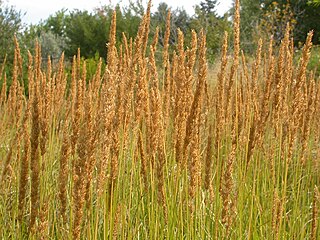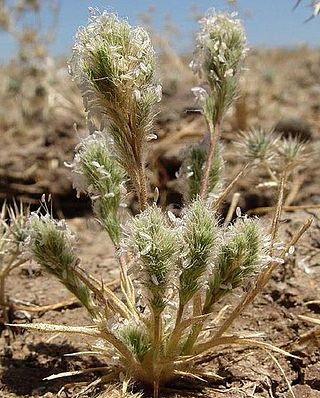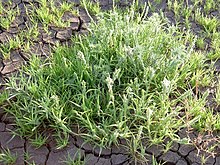
Festuca (fescue) is a genus of flowering plants belonging to the grass family Poaceae. They are evergreen or herbaceous perennial tufted grasses with a height range of 10–200 cm (4–79 in) and a cosmopolitan distribution, occurring on every continent except Antarctica. The genus is closely related to ryegrass (Lolium), and recent evidence from phylogenetic studies using DNA sequencing of plant mitochondrial DNA shows that the genus lacks monophyly. As a result, plant taxonomists have moved several species, including the forage grasses tall fescue and meadow fescue, from the genus Festuca into the genus Lolium, or alternatively into the segregate genus Schedonorus.

Calamagrostis epigejos, common names wood small-reed or bushgrass, is a species of grass in the family Poaceae which is native to Eurasia and Africa. It is found from average moisture locales to salt marsh and wet habitats.
The grass Tuctoria mucronata, which is known by several common names including prickly spiralgrass, Solano grass, and Crampton's tuctoria, is a federally listed endangered plant species endemic to two counties in northern California.

Lolium pratense, meadow fescue is a perennial species of grass, which is often used as an ornamental in gardens, and is also an important forage crop. It grows in meadows, roadsides, old pastures, and riversides on moist, rich soils, especially on loamy and heavy soils.

Neostapfia is a genus of endemic Californian bunchgrasses, in the subfamily Chloridoideae of the grass family, Poaceae. The only known species is Neostapfia colusana, with the common name Colusa grass.

Calamagrostis stricta, known as slim-stem small reed grass or narrow small-reed, is a species of bunchgrass in the family Poaceae of the Holarctic Kingdom.

Calamagrostis koelerioides, the fire reedgrass, dense-pine reedgrass, or the pineland reed grass, is a species of grass in the family Poaceae native to western North America. It ranges from western Wyoming to Washington state, south to Mexico. It is found in many habitat types, including mountain meadows, chaparral, pine and spruce forests, and on slopes, dry hills, and ridges.
Hordeum intercedens is a diploid, annual species of wild barley known by the common names bobtail barley and vernal barley. It is native to southern California and northern Baja California, where it is an increasingly rare member of the flora in saline and alkaline soils near seasonal waterflows and vernal pool habitats. Today most occurrences are located on the Channel Islands of California; many of the occurrences known from the mainland have been extirpated in the process of land development. This is an annual grass growing erect to bent in small tufts with stems up to 40 centimeters long. The inflorescence is a green spike up to 6.5 centimeters long made up of awned spikelets between 1 and 2 centimeters long.

Orcuttia is a genus of grass in the family Poaceae. Plants grow up to 20 cm (8 in) tall, usually with many stems emerging from the base of the plant, and forming a tuft. The spikelets are several-flowered, with reduced upper florets. The lemma tips have between two and five teeth.

Orcuttia californica is a rare species of grass known by the common name California Orcutt grass.
Orcuttia inaequalis is a rare species of grass known by the common name San Joaquin Valley Orcutt grass.

Orcuttia viscida is a rare species of grass known by the common name Sacramento Orcutt grass.

Melica ciliata, the hairy melic or silky spike melic, is a species of flowering plant in the grass family Poaceae, native to Europe, north Africa and temperate Asia. It has been introduced to South Australia.

Lolium giganteum, giant fescue, is a woodland grass that grows on neutral to base-rich soils, often near streams or other damp places. It is native to Europe and much of Asia and has been introduced to parts of North America.
Oplismenus thwaitesii is a flowering plant that is endemic to India.

Festuca brachyphylla, commonly known as alpine fescue or short-leaved fescue, is a grass native to Eurasia, North America, and the Arctic. The grass is used for erosion control and revegetation. The specific epithet brachyphylla means "short-leaved". The grass has a diploid number of 28, 42, or 44. This species was first described in 1827.

The Phoenix Vernal Pools are located in Fair Oaks, California, a suburb of Sacramento city around 20 miles east of the city of Sacramento and north of highway 50. This land consists of seasonally inundated wetlands that form after winter rains. The climate type of Phoenix Vernal Pools is classified as Mediterranean, receiving 24 in (610 mm) of rain per year. The rainwater percolates into the soil until it reaches an impermeable hardpan that causes an elevated water table, forming the vernal pools. The Phoenix Vernal Pool ecosystem is relatively unique as is supports many species of fauna and flora endemic to vernal pools.

Ischaemum rugosum, also known as saramollagrass, is a flowering plant belonging to the grass family Poaceae in the genus Ischaemum, and is native to tropical and temperate regions of Asia, growing in marshes and other wet habitats. It is a vigorous annual, and is an invasive species in South America and Madagascar. It reaches heights of up to 1 m and is primarily recognized by the ridged surface of its sessile spikelet’s lower glume. Despite its historic importance as fodder in Asia, the grass has become a major weed in mid-latitude rice paddies throughout Asia and South America.

Rottboellia cochinchinensis is a species of grass known by the common names Itchgrass,Raoul grass, corngrass, Kokoma grass, Guinea-fowl grass, jointed grass, Shamwa grass and Kelly grass. It is a tall, tufted annual grass whose stems (culms) grow up to 3 metres in height with leaf-blades of up to 45 centimetres in length. The species flowers at the apex of culms in the form of spike-like racemes composed of paired spikelets. The common name Itchgrass comes from the bristly (hispid) leaf-sheath which can be irritating to the skin.

Bromus texensis, the Texas brome, is an annual grass native to Texas.
















